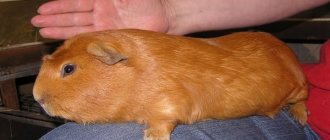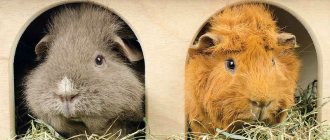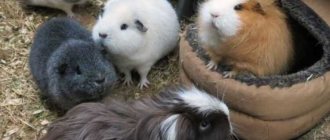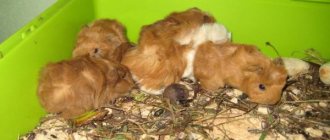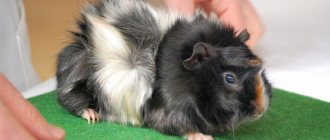The mumps itches often - this is an alarming symptom. It is probably natural for humans to project their own desires and feelings onto their pets. It’s not without reason that questions arise, say, about the possibility of treating a guinea pig to feijoa! It’s the same with itching: I’m itching and it’s just like that, maybe the mumps suddenly got an itch?
In principle, this is a very realistic point of view, because pigs can actually itch even in a completely healthy state - this is their way of hygienic self-care.
When should you sound the alarm?
All guinea pigs itch, this is a completely natural process - this is how they take care of their own hygiene. A pet may well scratch any place just like that, this is not a reason to sound the alarm. However, it is worth highlighting some factors that should alert the owner:
- The pig is constantly scratching one place.
- Dandruff is visible on the skin.
- The pig has become inactive or too irritable.
- Red spots, swelling, and black dots are visible on the skin.
- The hair began to fall out in places.
- Guinea pig bites itself and itches.
Any of these points, either individually or in combination with others, may indicate health problems for the guinea pig. Below we consider the main possible causes of scabies.
Parasites
A guinea pig may itch severely due to infestation with scabies mites. It settles in the deep layers of the skin and causes unbearable itching. The guinea pig begins to scratch its skin until it bleeds, the hair falls out, and pustules form. A guinea pig can become infected through food, hay, from other animals and even from people.
Another unpleasant parasite is the lice eater. With the help of a magnifying glass it can be seen on the skin of an animal. The pig's hair falls out, itching begins, and dandruff appears. The disease affects the back, perineum and croup. Mumps can become infected through food and from infected animals.
Severe scabies can be a symptom of a lice infestation. The pig's skin turns red and peels. The animal begins to behave strangely: jumps up, squeaks, and itches very much. You need to look for lice on the head and ears.
One of the most common parasites that affects guinea pigs is fleas. They bite pigs, causing them to itch. Flea bites can cause severe anemia. The pig loses its appetite, becomes lethargic and inactive.
Is your guinea pig itchy, eating little and drinking a lot? Perhaps she has worms. The parasite is very dangerous for guinea pigs. The animal begins to lose strength literally before our eyes, problems appear with the digestive system, in particular with the intestines.
What can you do at home?
Mild diarrhea. The general condition of the animal is good, but the droppings are thin and light. Eliminate green and succulent food from your diet; instead, give hay and warm chamomile tea, as well as willow branches and grated carrots. Make sure the litter is dry. If the droppings are not hard after two days, contact your veterinarian.
Constipation. If the so-called perineal pocket around the anus is filled with feces, gently squeeze it out and remove it with a damp cotton swab. If small, hard balls of stool appear, first check whether the drinking bowl is functioning correctly, since in most cases the cause of constipation is simply not enough water in the automatic drinking bowl. For several days, eliminate grain food from the diet and give your guinea pig cucumber or melon. If there is no improvement within 24 hours, contact your veterinarian. Allergic runny nose. Eliminate possible causes of this runny nose, such as dusty hay or harsh cleaning products that produce fumes. If in doubt, contact your veterinarian.
Heatstroke. If your guinea pig begins to move restlessly from side to side, itches and trembles all over, immediately place it in the shade and offer water at room temperature. The body should be carefully wrapped in a cool, damp towel, and the animal should be calmed with gentle stroking.
Guinea pig diet. If your guinea pig begins to gain weight, you need to put it on a diet. Fat animals are slower and more susceptible to disease. Give the animal only 40-60 g of succulent food per day and reduce the dose of the main food. Let your guinea pig go for walks often. Make her do various “exercises”, for example, put the lettuce on some elevation or place an obstacle on the way to the feeder so that the animal is forced to climb for food.
Veterinarian at home SAO
Refusal of food. Sometimes it happens that due to some illness a guinea pig refuses to feed. Only a veterinarian can answer the question of whether it can be cured with forced feeding. Refusal to feed has various reasons.
Misaligned teeth or bite problems are a serious hindrance to eating for guinea pigs. If the incisors and molars are incorrectly positioned, they grow continuously, and the animal is simply unable to take food.
A guinea pig may starve due to missing its mate, which can lead to its death. In most cases, a guinea pig, left alone, is very worried, sits in the corner of the cage and does not eat anything, because it cannot bear the loss of a friend. Even if she does not refuse food, this does not mean at all that the animal feels well. In any case, it is better to add a new partner to her. She will probably enjoy the company of a young guinea pig aged 6-10 weeks. As the animals get used to each other, act carefully and give them the opportunity to establish contact.
Note. Do not try to replace your guinea pig's lost friend with yourself, as at one point you will feel that this is too burdensome for you, and the guinea pig will certainly suffer from this.
Allergy
Scabies can be the result of an allergy. The animal can scratch one place until wounded, its hair falls out, its eyes water, there is sneezing and shortness of breath. The cause may be a food allergy or an allergy to bedding.
The immunopathological process can be caused by pine sawdust, which releases substances that irritate the respiratory tract. Constant contact with skin and fur can cause a severe allergic reaction over time. If your guinea pig shows signs of allergies, you need to change the bedding to cellulose or corn.
If a guinea pig has a food allergy, identifying the exact source is not so easy. It is advisable to get tested. However, you can also try to determine the source of the problem at home by combining different foods and carefully observing the animal. The component that causes an allergic reaction should be completely excluded from the diet.
Allergic pig?
The most rare, but still can cause itching, is food allergy. You can “calculate” the moment when the pig begins to itch almost shortly after its meal. In addition to this symptom, the following are also noted:
- anxiety;
- licking;
- cough;
- lacrimation;
- swelling of the eyelids;
- sneezing.
Pigs with this diagnosis jump around the cage and twitch.
The culprit of allergic itching can also be the bedding in the animal’s cage.
It is recommended to use antihistamines and replace food and bedding that could cause an allergic reaction.
Fungus
A guinea pig may itch due to shingles. Most often it can be seen on the face. Without treatment, it spreads throughout the body. If a flaky spot appears on the skin, hair falls out, a wound has formed, and the guinea pig often scratches it - perhaps the cause is a fungus.
A guinea pig can catch shingles from other infected animals. Also, the reasons for its appearance can be stress, age, too high humidity in the cage, wet bedding. Ringworm can also appear against the background of other diseases. For example, against the background of allergies or parasite infection.
Vitamin deficiency
Another cause of scabies can be vitamin deficiency, which is associated with a poor diet and lack of succulent plant food. The animal begins to develop scabies, a rash appears on the skin, and hair falls out. The pig is inactive and suffers from constipation. All this can result from a lack of vitamin C in food.
It is necessary to take the animal to the doctor to rule out infection by parasites, fungus and allergies as possible causes of scabies. If the doctor diagnoses Autominosis, it is necessary to increase the amount of food containing vitamin C. For example, you can hang a bunch of parsley rich in it in the cage.
What should be of concern?
From time to time it is worth examining the fur and skin of the animal to see if it is combed (sometimes until it bleeds), if dandruff, bald spots, peeling, and skin parasites are observed.
Don't be alarmed by the sight of bald patches behind the ears and on the inside of the front legs - this is a normal appearance for all pigs.
If these symptoms occur, the most logical thing to do is urgently do an appropriate test - a scraping - to identify parasites and fungus on the skin.
Why does a guinea pig squeak?
Stress
Stress can cause problems with the nervous system, so the guinea pig will begin to itch, lose hair and lose appetite. There can be many reasons for this little animal's stress. One of the main ones is poor living conditions, due to which the guinea pig is constantly in an uncomfortable and irritable state. Stress can accumulate and result in serious health problems.
If a guinea pig chews on the cage, then the cage is too small for it: these animals are not that small, and therefore require space.
Other pets can cause stress. For example, cats who like to watch the rodent from the side, and in the absence of the owner are not averse to sticking their paw into the cage.
Constant noise and vibration can unnerve your pet, so there is no need to place the cage near speakers or a TV.
Video “Cutting a guinea pig’s claws”
To ensure that your pet pig does not have pododermatitis, you should trim its claws on time, and the video will further demonstrate how to do this.
Sorry, there are no surveys available at this time.
Was this article helpful?
Thank you for your opinion!
The article was useful. Please share the information with your friends.
Yes (100.00%)
No
X
Please write what is wrong and leave recommendations on the article
Cancel reply
Rate the benefit of the article: Rate the author ( 5 votes, average: 4.80 out of 5)
Discuss the article:
Treatment
Have you noticed that your guinea pig is itching, what should you do first? It is necessary to carefully examine the animal and note any deviations from the normal state.
If your guinea pig is itching from stress, carefully analyze the animal's living conditions and eliminate all possible causes of anxiety.
But if the causes of scabies cannot be visually determined, immediately take your pet to the veterinarian. He will take scrapings from the skin and send them for analysis. Only by determining the exact cause of scabies can the correct treatment be prescribed.
Fungal diseases
The next reason why a guinea pig goes bald is diseases caused by a fungus. These include lichen and dermatophytes. Both diseases most often begin to appear first on the face, then move to the paws, neck and spread throughout the body. The fungus causes severe itching, the formation of bald patches and purulent wounds at the site of scratching. Ringworm can not only be transmitted to humans, but also lead to the death of the animal. If the infection is severe, the itching can become so severe that the guinea pig loses its appetite and dies from exhaustion and dehydration.
Prevention of all fungal diseases is to maintain the required humidity in the room where the cage is located, regularly change the bedding and regularly treat the animal for skin and intestinal parasites, and high-quality food. When purchasing a new guinea pig, especially at a pet store, it is necessary to provide the animal with a two-week quarantine and only then place the pet with other animals. 14 days is a sufficient period to determine the presence of skin diseases and other abnormalities in the animal.
If your guinea pig gets sick and your veterinarian confirms the diagnosis, you need to start treatment as soon as possible. The sick animal must be separated from all the others, and the cage must be disinfected with any strong chlorine-containing solution.
To combat fungal diseases, treatment with Nizoral shampoo, which is sold in any pharmacy, is recommended.
Nizoral has proven itself in the fight against many types of fungus, it relieves inflammation and itching, and reduces peeling of the skin. Nizoral is applied to the affected areas of the guinea pig's skin for five to seven minutes, then washed with warm running water. It is strictly forbidden to bathe the whole animal - water procedures are extremely stressful for a guinea pig. In addition to Nizoral, Fungoterbin 1% cream helps in the fight against fungus. It fights against dermatophytes, molds, and yeasts. You can also use Thermikon 1% cream or a spray with the same name and composition. Both creams are applied to the affected areas of the skin two to three times a day. Fukortsin or Castellani also cope well with fungal diseases.
Prevention
Quite often, the reason a guinea pig becomes infected with parasites is through interaction with other animals. Pay attention to this. Walking an animal outside on green grass may not have the most pleasant consequences.
Guinea pigs can be kept together in same-sex pairs. If one of the pair gets sick, temporarily isolate the individual from the healthy animal. The cage, feeder and house must be washed thoroughly with disinfectants and dried. If you just bought a second animal from a pet store, temporarily quarantine it and monitor its health before introducing it to other pets.
It is necessary to carefully monitor the cleanliness of the cage. Pigs quickly contaminate the bedding with urine, which can cause irritation and inflammation. It needs to be changed on time.
At least once a month, you should inspect your guinea pig's body for wounds, irritations or inflammation. If you notice anything strange, you should immediately contact a veterinarian.
Diseases caused by vitamin deficiency and viruses
- Vitamin deficiency in guinea pigs causes diseases such as scurvy, focal baldness, allergic reaction, itchy skin, decreased immunity and colds.
- Conjunctivitis is a purulent inflammation of the mucous membrane of the eyelids, which often accompanies excessive growth of molars, keeping the animal in a dusty room, due to chemical irritants. First, the animal's eyes become swollen and red, then the appearance of pus causes the eyelashes to stick together and tearing increases. Then the eyelids completely stick together from pus and if the disease is not treated, the mumps will go blind. It is advisable not to self-medicate for conjunctivitis because it may be an indirect sign of a cold that will turn into pneumonia or an indirect sign of overgrown teeth. Remember to practice good personal hygiene and wash your hands after treating your pet.
- Rickets occurs due to a lack of calcium and vitamin D. It usually occurs in young pigs in winter. They recommend a trivitamin, irradiation with a quartz lamp, and adding salt to the diet. With rickets, the limbs are twisted, the joints are thickened, the animal is depressed and stunted.
- Paratyphoid fever is an infectious disease that begins due to damage to the pig's body by microorganisms that enter with drinking water and feed. A sick animal refuses food, its fur becomes sticky, and its eyes become dull. Antibiotic treatment is prescribed only by a doctor.
- Pasteurellosis causes a runny nose. The disease begins with moistening of the hairs around the nostrils, then sneezing appears. The nose itches and the animal rubs it with its paws. Then mucus appears from the nose, turning into pus. The pig's breathing becomes heavy and wheezing. All this is accompanied by decreased appetite and lethargy. The disease is chronic and lasts a long time. During an exacerbation, ulcers appear on the body, high fever and convulsions rise. Pasteurellosis cannot be cured. Animals with severe symptoms of the disease are euthanized. At the beginning of the disease, when the symptoms are not clear, they are treated with antibiotics and sulfa drugs.
- Wounds can occur in the event of a fight with a relative or an attack on an animal by a cat or dog. The hair around the wounds is cut off, the wound is washed and dried using hydrogen peroxide or a solution of potassium permanganate in a ratio of 1:1000. Then it is lubricated with Levomekol, synthomycin or streptocyte ointment until it is completely cured.
- Fractures and cracks in bones occur during a fall. Swelling occurs at the site of injury, and there may be muscle damage with an open fracture. There is always severe pain. The animal will limp for the rest of its life. The fracture must be treated in a clinic.
- Diseases of the digestive system are associated with the structural features of the intestines. In rodents it is very long, and food takes a long time to digest in it. Changing feeds and an excess of juicy vegetables leads to intestinal upset and diarrhea. The owner of a rodent should know that the introduction of new food should begin with minimal portions, in the morning, with a gradual increase and replacement of the usual diet. This is done when absolutely necessary. Or with the change of season, when you need to introduce fresh grass into your diet. To correct nutritional errors, give activated carbon and a weak pink solution of potassium permanganate instead of drinking.
- Flatulence requires examination by a veterinarian. The formation of gases in the colon area often causes disturbances in the functioning of the respiratory and cardiovascular systems. In rodents, this disease leads to death from suffocation or cardiac arrest. You can relieve flatulence with massage or gymnastics. The animal must be released to run around.
- Infection of the salivary gland with cytomegalovirus and herpes virus occurs through water. In some cases, guinea pigs develop a fever and increased drooling. After some time, the immune system expels the virus and the disease goes away. Re-infection is excluded, since antibodies against these viruses have appeared in the body.
- Enteritis is accompanied by diarrhea, bloating and loud rumbling in the intestines; with these signs, the rodent should be urgently taken to the veterinarian. The cause may be moldy feed. A urine test is taken, which shows the presence of ketone bodies. Treatment of enterocolitis involves restoring the intestinal microflora. To do this, exclude all feed except high-quality hay. In summer, you can collect yarrow, chamomile, red clover, plantain, nettle, dry the herbs on an iron tray and feed this to the animal for 3 days. Glucose is added to the water, dissolved feces from healthy pigs are given, which improves the intestinal microflora. It is diluted in water and injected into the oral cavity through a syringe once a day. There is no need to prevent pigs from eating their own droppings. This will only benefit them. The list of diseases can be kept endlessly, but only a veterinarian can make the correct diagnosis.
Any disease with fever, accompanied by pain and discharge requires the attention of a veterinarian. Call the phone number listed on the website and ask all your questions.
